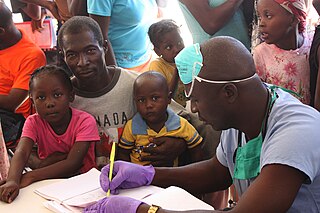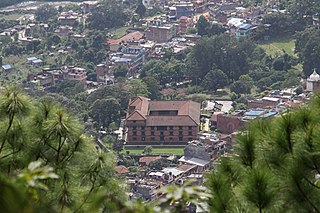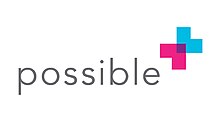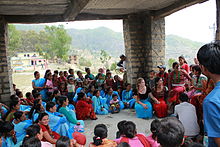
The current population of Nepal is 29,164,578 as per the 2021 census. The population growth rate is 0.92% per year.

Partners In Health (PIH) is an international nonprofit public health organization founded in 1987 by Paul Farmer, Ophelia Dahl, Thomas J. White, Todd McCormack, and Jim Yong Kim.

Chhaupadi is a form of menstrual taboo which prohibits women and girls from participating in normal family activities while menstruating, as they are considered "impure". Chhaupadi is said to be practiced primarily in the western part of Nepal, but the same is true for city dwellers also. It is practiced all over the country with different names and practiced in different ways.

Geisinger Health System (GHS) is a regional health care provider to central, south-central and northeastern Pennsylvania. Headquartered in Danville, Pennsylvania, Geisinger services over 3 million patients in 45 counties.

Gorkha District, a part of Gandaki Province, is one of the 77 districts of Nepal, and the fourth largest district of Nepal in terms of area. It is historically linked with the creation of modern Nepal and the name of the legendary Gorkha soldiers. The district, with Gorkha Municipality as its district headquarters, covers an area of 3,610 km2 (1,390 sq mi) and has a population of 252,201 according to the 2021 Nepal census. Gorkha district is the site of the Manakamana Temple. The temples of Gorakh Nath and Gorakh Kali are found in the district. Several major rivers—the Chepe, Daraudi, Marsyangdi, Budi Gandaki, and Trishuli—run through the district.

Humla District, a part of Karnali Province, is one of the seventy-seven districts of Nepal. The district, with Simikot as its district headquarters, covers an area of 5,655 km2 (2,183 sq mi) and has population of 50,858 as per the census of 2011. Namkha is the largest rural municipal which lies in humla Humla is the 2nd largest district of Nepal. The southern and middle parts of Humla District are inhabited by Khas communities, originating from Sinja valley, whereas the higher and northern parts of Humla are mostly inhabited by culturally Tibetan communities.

Sindhupalchowk District is a part of Bagmati Province and one of the seventy-seven districts of Nepal, with an area of 2,542 km2 (981 sq mi). The district's headquarters is in Chautara. In 2006, 336,478 people resided in 79 village development committees, in 2011 there were 287,798.
The National Abortion Federation (NAF) is the professional association of abortion providers. NAF members include private and non-profit clinics, Planned Parenthood affiliates, women's health centers, physicians' offices, and hospitals who together perform approximately half of the abortions in the U.S. and Canada each year. NAF members also include public hospitals and both public and private clinics in Mexico City and private clinics in Colombia. Katherine Hancock Ragsdale, an Episcopal priest, was the President and CEO of NAF until October 2021. As of November 2021, NAF is searching for a new President and CEO.

In 2022, Freedom House rated Nepal’s human rights at 57 out 100.

Chitrakar is a caste within the Newar community of the Kathmandu Valley in Nepal. The Newar caste system is divided according to profession. Accordingly, Chitrakars were painters and mask makers.

Direct Relief is a nonprofit humanitarian organization whose mission is to improve the lives of people in poverty or emergency situations by providing the appropriate medical resources. The charity provides emergency medical assistance and disaster relief in the United States and internationally. The organization is headed by an independent board of directors and its president and CEO, Thomas Tighe.

Dhulikhel Hospital, a Kathmandu University hospital, is an independent, not for profit, non-government hospital in Dhulikhel, Kavrepalanchok, Nepal.

Joia Stapleton Mukherjee is an associate professor with the Division of Global Health Equity at the Brigham and Women's Hospital and the Department of Global Health and Social Medicine at Harvard Medical School. Since 2000, she has served as the Chief Medical Officer of Partners In Health, an international medical non-profit founded by Paul Farmer, Ophelia Dahl, and Jim Kim. She trained in Infectious Disease, Internal Medicine, and Pediatrics at the Massachusetts General Hospital and has an MPH from Harvard School of Public Health. Dr. Mukherjee has been involved in health care access and human rights issues since 1989, and she consults for the World Health Organization on the treatment of HIV and MDR-TB in developing countries. Her scholarly work focuses on the human rights aspect of HIV treatment and on the implementation of complex health interventions in resource-poor settings.

Grinnell Regional Medical Center (GRMC) is an American private, nonprofit and non-tax supported 49-bed rural community hospital in Grinnell, Iowa. With 50 physicians and allied healthcare professionals, 400 employees, and more than 300 volunteers, it serves an estimated 47,000 residents in east-central Iowa in the counties of Poweshiek, Jasper, Benton, Iowa, Mahaska, and Tama. GRMC is located at 210 Fourth Avenue in Grinnell.
Citizens Memorial Healthcare (CMH) is a fully integrated rural healthcare system. CMH provides comprehensive care to the residents of eight counties in southwest Missouri. CMH refers to two affiliated corporate entities. Citizens Memorial Hospital District is a Missouri public hospital. Citizens Memorial Health Care Foundation is a 501(c)3 non-profit corporation.

Sanduk Ruit is an ophthalmologist from Nepal who has restored the sight of over 180,000 people across Africa and Asia using small-incision cataract surgery.

EMMS International is a Non-governmental Organization (NGO) that provides medical aid to countries around the world and operates offices in the UK. Founded to provide clinical education and medical aid to people in need in Scotland, it later expanded to the Middle East, South Asia, and Africa through sponsoring the construction of dispensaries and hospitals. Its education expanded from training physicians in Edinburgh to training local nurses and physicians in the countries where it works. EMMS continues to provide resource assistance at all its sites. Based in Scotland, its vision is health for today, hope for tomorrow.
Tilganga Institute of Ophthalmology, formerly called the Tilganga Eye Centre, in Nepal is the implementing body of the Nepal Eye Program, a non-profit, community based, non-government organization launched in 1992. It was founded in part by renowned ophthalmologist and cataract surgeon Sanduk Ruit. The current facility was opened in 1994. The World Health Organization recognized Tilganga Institute of Ophthalmology as a WHO Collaboration Centre of Ophthalmology in 2019. In Nepal, it is the second institute, and first institute in the field of ophthalmology to receive this designation. It provides various sub speciality services of Ophthalmology such as Cornea, Cataract & IOL, Glaucoma, Oculoplastic, Lacrimal and Ocular Oncology services, Pediatric Ophthalmology and Strabismus services, Vitreo-Retina, Uvea, Neuro ophthalmology and Optometry services.

Friends Without A Border (Friends) is a nonprofit, nongovernmental organization that funds medical treatment and healthcare programs serving disadvantaged children and their families in Southeast Asia. Founded in 1996 by photographer Kenro Izu, Friends provides direct financial and program support to Angkor Hospital for Children in Siem Reap, Cambodia, Lao Friends Hospital for Children in Luang Prabang, Laos, and The Lake Clinic in Siem Reap, Cambodia.
Tansen United Mission Hospital is located in the Palpa district of Nepal. The hospital serves thousands of patients from western Nepal and northern India, and is part of a broader healthcare network. The hospital is part of United Mission to Nepal. The hospital was started on 15 June 1954. Besides providing basic health services, it is involved in community health education. It is one of few hospitals in Nepal with its own pharmacy।

















